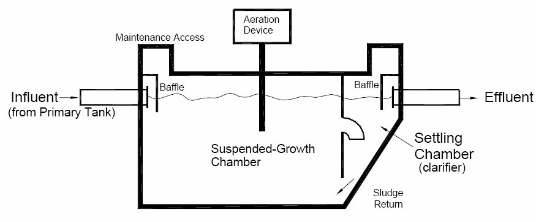
An aeration unit also works independent of soil absorption. This type of system uses aerobic (with oxygen) bacteria to break down the solids rather than the anaerobic-type bacteria found in septic tanks. Specifically approved units are allowed to discharge to farm tiles, river, etc.
Advantages:
- Only a small area needed for installation
- High water table does not interfere with function
- Discharge site is only 20 to 40 inches below ground level
- Does not depend upon soil to absorb septic tank effluent
Disadvantages:
- High maintenance cost
- After 2 year initial contract, yearly maintenance contracts may be purchased from the
distributor - Continuing cost of electricity to run aerator and other necessary pumps and alarms
When choosing which type of system to use, certain factors must be considered so that the system selected will best serve the individual’s needs:
- Type of soil on the property
- Topography (lay of the land)
- Lot size; available property for the installation
- Surrounding features – wells (both yours and the neighbors’), water lines, property lines, driveways, etc.
Do…
- Maintain the service arrangement offered by the manufacturer after the initial two-year period has expired. It is very important that aerobic units receive regular maintenance.
- Keep your system accessible for inspections and pumping, yet protected from unauthorized entrance. If access to your system is locked, make sure that your service contractor has a key.
- Call a service professional whenever you experience problems with your system, whenever the alarm is activated, or whenever there are any signs of system failure.
- Keep detailed records about your aerobic system, including a map of where it is, and general information, such as model name, capacity, state license, date installed, contract service agreement, records of service visits, and maintenance performed.
- Conserve water to avoid overloading the system. Be sure to repair any leaky faucets or toilets.
- Divert other sources of water, like roof drains, house footing drains, and sump pumps away from the aerobic system.
- Become familiar with how your own particular system operates, and the way it looks, sounds, and smells when it is working correctly. This way, you may be able to identify problems before they become serious and alert your service provider to anything unusual.
- Be sure to ask your service provider questions about how to know if your unit is malfunctioning.
Don’t…
- Flush medications down the toilet or allow them to go down any drain. Many medications kill off the microorganisms living in the aerobic unit that are essential for proper treatment of sewage.
- Go down into a septic tank. Toxic gases are produced by the natural treatment processes in septic tanks and can kill in minutes. Extreme care should be taken when inspecting a septic tank, even when just looking in.
- Wash all of the clothing in one day. Loads of laundry must be staggered throughout the week, ideally one or two loads daily. Too much soap in the unit at one time can cause excessive foaming, causing problems and possibly failure of your aerobic unit.
- Allow anyone to drive or park over any part of the system.
- Plant anything over or near the drainfield except grass. Roots from nearby trees or shrubs may clog and damage the drain lines.
- Make or allow repairs to your aerobic system without obtaining the required health department permit. Use professional licensed septic contractors when needed.
- Use a garbage disposal without checking with your local regulatory agency to make sure that your aerobic system can accommodate this additional waste.
- Use your toilet as a trash can or poison your aerobic unit and the groundwater by pouring harmful chemicals and cleansers down the drain. Harsh chemicals can kill the beneficial bacteria that treat your wastewater.
- Attempt to clean or perform maintenance on any sealed aerobic unit components.
- Allow water softener backwash to enter your aerobic system before checking with your local regulatory agency.
REMEMBER:
Aerobic treatment plants must be maintained and monitored frequently.
They should be pumped out by an Illinois licensed
pumping contractor every 3-5 years, or as often as needed.
